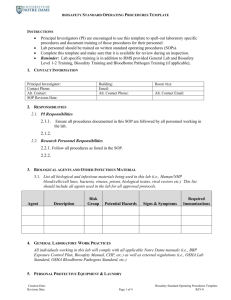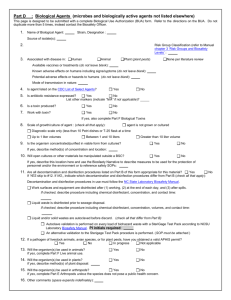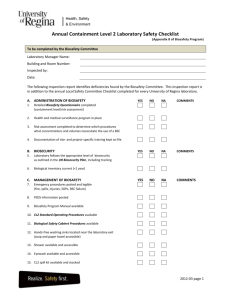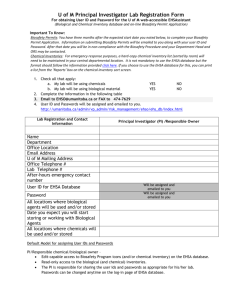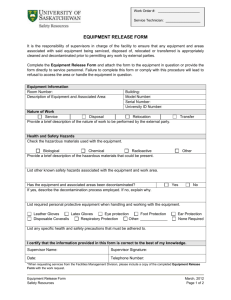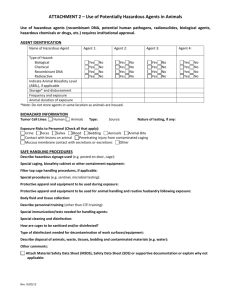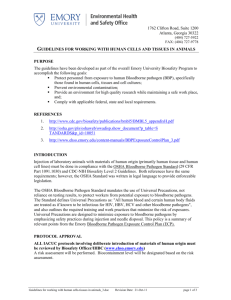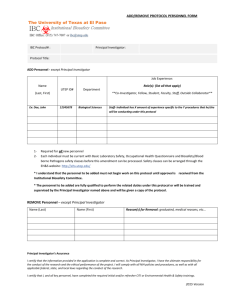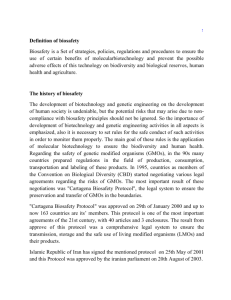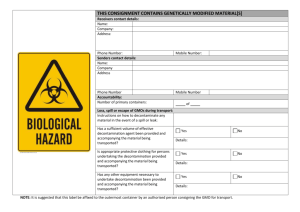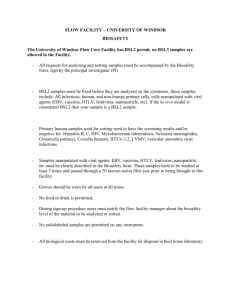Biosafety Standard Operating Procedures Template
advertisement
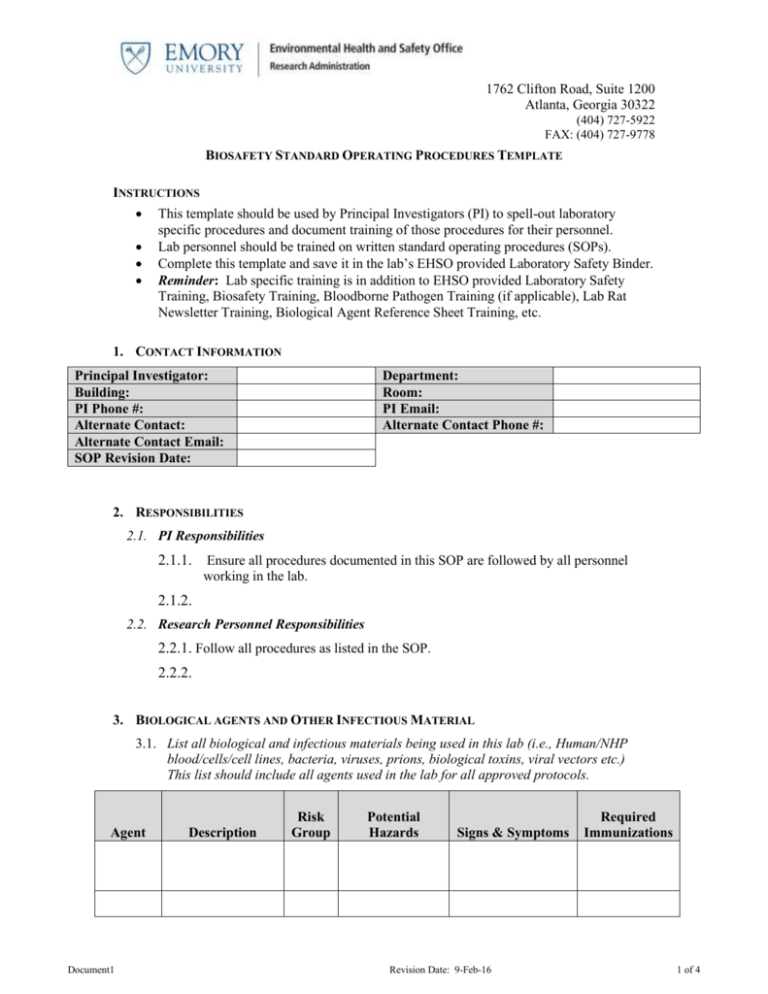
1762 Clifton Road, Suite 1200 Atlanta, Georgia 30322 (404) 727-5922 FAX: (404) 727-9778 BIOSAFETY STANDARD OPERATING PROCEDURES TEMPLATE INSTRUCTIONS This template should be used by Principal Investigators (PI) to spell-out laboratory specific procedures and document training of those procedures for their personnel. Lab personnel should be trained on written standard operating procedures (SOPs). Complete this template and save it in the lab’s EHSO provided Laboratory Safety Binder. Reminder: Lab specific training is in addition to EHSO provided Laboratory Safety Training, Biosafety Training, Bloodborne Pathogen Training (if applicable), Lab Rat Newsletter Training, Biological Agent Reference Sheet Training, etc. 1. CONTACT INFORMATION Principal Investigator: Building: PI Phone #: Alternate Contact: Alternate Contact Email: SOP Revision Date: Department: Room: PI Email: Alternate Contact Phone #: 2. RESPONSIBILITIES 2.1. PI Responsibilities 2.1.1. Ensure all procedures documented in this SOP are followed by all personnel working in the lab. 2.1.2. 2.2. Research Personnel Responsibilities 2.2.1. Follow all procedures as listed in the SOP. 2.2.2. 3. BIOLOGICAL AGENTS AND OTHER INFECTIOUS MATERIAL 3.1. List all biological and infectious materials being used in this lab (i.e., Human/NHP blood/cells/cell lines, bacteria, viruses, prions, biological toxins, viral vectors etc.) This list should include all agents used in the lab for all approved protocols. Agent Document1 Description Risk Group Potential Hazards Signs & Symptoms Revision Date: 9-Feb-16 Required Immunizations 1 of 4 BIOSAFETY STANDARD OPERATING PROCEDURES TEMPLATE 4. GENERAL LABORATORY WORK PRACTICES All individuals working in this lab will comply with all applicable Emory EHSO manuals (i.e., BBP Exposure Control Plan, Biosafety Manual, etc.) and guidelines (i.e., Food and Drink Guidelines, Sharps Guidelines, Viral Vector Guidelines, Waste Disposal Guidelines, etc.), as well as external regulations (i.e., OSHA Lab Standard, OSHA Bloodborne Pathogens Standard, etc.) 5. PERSONAL PROTECTIVE EQUIPMENT & LAUNDRY 5.1. List all PPE required to work in this lab. If it is reusable, explain how it is decontaminated / laundered. If it is not reusable, explain how it is disposed of: PPE Decontamination, Laundry or Disposal Method 6. TRAINING 6.1. EHSO Training Requirements Based on Agents Used: Training Research Laboratory Safety Training Bloodborne Pathogens for Researchers Training Biosafety Training Monthly Lab Rat Newsletter Respiratory Protection Training Noise Training General Laser Safety Training Herpes-B Virus Training Biological Agent Reference Sheets (BARS) Is this applicable? YES YES YES 6.2. Lab Specific Training Requirements: Lab Specific Training 7. BIOLOGICAL WASTE DISPOSAL Describe how each of the following biological wastes will be disposed of in the lab (as applicable): Waste Solid Waste Sharps Waste Liquid Waste Disposal Procedures 8. DECONTAMINATION PROCEDURES List all disinfectants and decontamination procedures that will be used in the lab: 8.1. Disinfectants to be used in this lab (Disinfectants are agents, usually chemical, that inactivate viruses or kill vegetative microbes but do not necessarily destroy resistant forms such as spores): Document1 Revision Date: 9-Feb-16 page 2 of 4 BIOSAFETY STANDARD OPERATING PROCEDURES TEMPLATE 8.1.1. 8.2. Decontamination Procedure (Decontamination is the disinfection or sterilization of contaminated articles or surfaces that make them suitable for use): 8.2.1. 9. ENGINEERING CONTROLS Describe the applicable engineering controls that will be used to minimize the risk of exposure to biological and hazardous materials: 9.1. Biosafety Cabinets (BSC): Building Room Number Make Model Serial Number Date Last Certified 9.2. Chemical Fume Hood: Building Room Number Date Last Certified 9.3. Centrifuge: 9.3.1. 9.4. Other: 9.4.1. 10. TRANSPORTATION OF BIOLOGICAL SAMPLES Explain the procedures for the transport of biological samples: 10.1. Non-Vehicle Intra-Campus Transportation: 10.1.1. 10.2. Personal or University Vehicle Transportation: 10.2.1. 10.3. Provide information on who is trained to ship biological/infectious material/dry ice (if applicable): 10.3.1. Name: 10.3.2. Training Expiration Date: 11. EMERGENCY PROCEDURES Explain how each of the following spill/splash emergencies will be handled. For guidance, refer to the Just in Time – Guide to Campus Emergencies. Every lab should have a Just in Time Guide to Campus Emergencies flip chart, provided by EHSO, posted in the lab and all personnel should be familiar with the contents. 11.1. A minor spill inside the BSC: 11.1.1. 11.2. A major spill inside the BSC: Document1 Revision Date: 9-Feb-16 page 3 of 4 BIOSAFETY STANDARD OPERATING PROCEDURES TEMPLATE 11.2.1. 11.3. A spill outside the BSC : 11.3.1. 11.4. Explain how spills/splashes involving personnel will be handled: 11.4.1. 12. INCIDENT REPORTING 12.1. All incidents, major or minor, must be reported to the Emory STARS Reporting System. 12.2. EHSO will follow up on any reported incident in an attempt to improve laboratory safety and its reporting system. 12.3. For all first aid procedures, refer to the Just in Time – Guide to Campus Emergencies. 13. SIGN OFF DOCUMENTATION 13.1. Principal Investigator Certification: 13.1.1. I hereby certify that I have reviewed these practices and procedures and they represent the current operating practices in my laboratory. Principal Investigator Name Principal Investigator Signature Date 13.2. Personnel Certification: 13.2.1. We, the undersigned, have reviewed these practices and procedures, have been trained in the appropriate methods and practices for handling potentially infectious material and agree to follow the stated practices and procedures. We understand that we must review and document compliance with these practices and procedures on an annual basis. Personnel Name Document1 Personnel Signature Revision Date: 9-Feb-16 Date page 4 of 4
